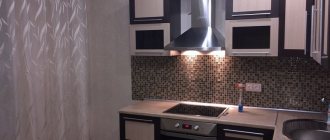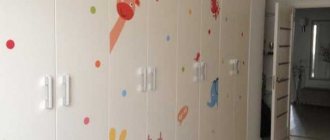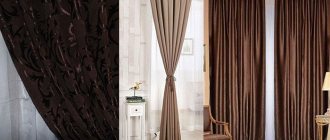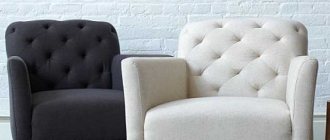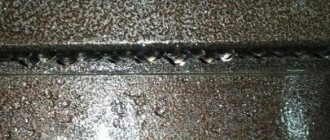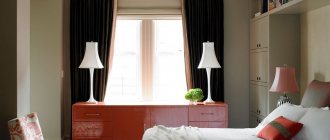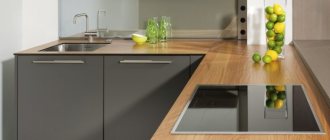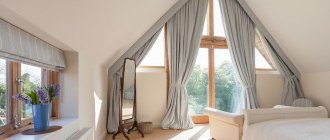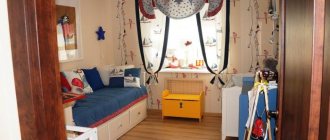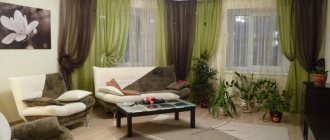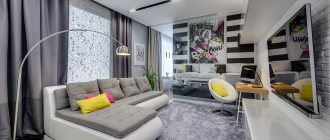Choosing curtains depending on the purpose of the room
According to their types, curtains are divided into horizontal and vertical. According to their purpose, they are divided into curtains and curtains. The first ones are sewn from dense, heavy fabrics (satin, velvet, polyester, taffeta). The latter are made of light, airy materials to diffuse light and partially protect the room from the outside world. Fabrics such as veil, organza, and muslin are used.
Lambrequin
Kitchen
The kitchen area is rich in all sorts of odors of cooking products and evaporated moisture. Fabrics used in the kitchen should be easy to care for, resistant to fading and transmit light. They use cotton fabric, natural fabrics and with synthetic additives, organza. The kitchen can be decorated with three-color checkered or brightly printed curtains.
Kitchen cotton curtains
Living room
The room for receiving guests should have a certain interior, decorated with velvet, brocade, silk, satin, jacquard. These are the fabrics chosen for the living room. This room characterizes the wealth and respectability of the owner. The types of fabrics for curtains are varied.
Living room
Bedroom
The sleeping room should be protected from daylight. Maximum rest and recovery take place in a well-insulated room. To decorate window openings, curtain fabrics such as polyester, taffeta, viscose and linen are used. Bright and variegated colors are not welcome.
Bedroom
Children's
The baby's room should allow light to pass through when he is awake and be shaded during sleep. Easy-to-care fabrics are used. Cotton and linen curtains can be replaced with mixed fabrics based on silk or taffeta. A prerequisite is the provision of environmentally friendly materials that do not cause allergies.
The choice of colors is individual. Some children manage to fall asleep looking at bright pictures and patterns, others prefer a darkened room without external stimuli. The fabric for curtains can be different.
This might interest you. Is it possible to independently calculate the consumption of fabrics for sewing bed linen?
Children's room
Children's
The room places special demands on the choice of fabric for curtains: they must be made of hypoallergenic natural materials and at the same time have a high wear resistance and be easy to use. Therefore, a small admixture of synthetic fibers in the fabric is very welcome.
If we talk about how to choose the color of fabric for curtains in a children's room, then there are no restrictions. Bright and pastel, patterned and solid, smooth and textured, they all look good. The priority factor in the choice should be on the side of the overall harmony of the room.
What kind of curtain fabric should it be?
The qualitative characteristics of the material set the style of the future interior. The artistic design of the entire room depends on correctly selected curtains. The cost does not always justify the quality and appearance of the material.
The following fabric characteristics are in demand:
- wear resistance;
- light transmittance;
- sound absorption;
- permanent color;
- crease resistance;
- rigidity of shape;
- a certain weight of the canvas;
- possibility of drapery;
- UV resistance;
- ease of care;
- affordable price.
Color combination of drapes and curtains
Features, varieties
The main difference between curtain fabric and tulle fabric is its high density. Such curtains drape well and hold their shape, and are used for both windows and doorways. Curtain fabric is equally suitable for sewing curtains, tablecloths, pillowcases, pillows or upholstery. Its peculiarity is that it gives the room a cozy atmosphere. Several requirements for a good curtain fabric: durability, practicality, strength, variety of colors.
Porter can be represented by the following types of material:
- atlas,
- velvet,
- blackout,
- velours,
- veil,
- jacquard,
- linen,
- organza,
- satin,
- taffeta,
- silk,
- chenille
The modern textile industry offers a large selection of synthetic fabrics. The reason for their popularity is ease of care, practicality, affordability and an incredible variety of colors. Natural and semi-natural fabrics have the advantage of being environmentally friendly. The curtain fabric is additionally treated with special solutions that protect it from fading under sunlight, neutralize static electricity, increase wash resistance and prevent the accumulation of odors. Natural materials are treated with moth-repellent compounds.
Which curtain fabric is best to choose?
Depending on where the curtain will hang, the material is selected according to the main criteria that meet the buyer’s needs.
- By color you can determine the purpose of the future canvas. Bright solid colors or a jacquard pattern style can be used in the living room. Be sure to match the color of the curtain with the solidity of the furniture.
- According to the structure of fiber weaving. Curtains made of matting or burlap are not suitable for expensive Italian furniture. The uniform style of the interior is controlled by the designer's taste.
- Multilayer curtains on a high and narrow window will not look good if the design is narrowed in space. Light colors are used to expand the room.
- The density of the fabric and the presence of patterns do not allow the creation of multi-layer curtains. And the fragility of the lambrequin design can upset any housewife after the first wash.
Note! In interior design, many factors must be taken into account. Classic style will help in any case.
Jacquard
Long lasting material. Densely intertwined fibers create a relief pattern that is equally beautiful on both sides of the curtain fabric. Looks perfect in a living room or living room.
Matting fabric for curtains
Curtain fabric, reminiscent of burlap, adds zest to the interior, making it cozy. Thick fabric protects well from ultraviolet radiation. Environmentally friendly material made of cotton, linen or with the addition of silk, acrylic or polyester. The composition of the matter may change, but the pattern remains unchanged. The interweaving of paired threads creates a semblance of a “chessboard”. Suitable for the kitchen and living room, combined with unvarnished wooden furniture in light colors.
Jacquard curtains
Linen
Durable fabric made from natural ingredients. Retains sharp folds used in blinds and pleated curtains. The rigid base does not allow the fabric to drape, so linen curtains are used straightened in one plane.
You may be interested in: Using eco-leather for car covers
Organza
Airy material with high strength indicators can be matte or shiny. Used for the manufacture of multi-layer curtains. Draps easily.
Note! Easy care of the material allows it to be used in sewing numerous assembled ruffles.
Velvet
Fabric for curtains with pile based on cotton, silk or viscose fibers. They add luxury to the interior, protect the room well from light and create an atmosphere of mystery and glamor. Velvet drapery is heavy, but retains heat perfectly and gives the room a solemn style. The material is expensive, not wear-resistant, loses color when washed and quickly loses its lint.
Matting curtains
Cotton
Durable natural fabric, easily withstands multiple washes, steams well and irons with a hot iron. The relative rigidity of the material helps maintain the shape of the drapery. It has the only drawback - shrinkage after washing.
Nylon
The elastic material of artificial origin will soon celebrate its 100th anniversary. The quality characteristics are close to silk. Durable and lightweight material is easy to paint. The elasticity of curtain fabric depends on the density, which varies depending on the purpose of the fabric. Widely used in the manufacture of various types of clothing. Easy care for nylon products, requiring almost no ironing. Wash in water at room temperature. Easily washes off all kinds of dirt.
Opaque nylon
Atlas
Fabric with a shiny front surface is highly durable and wear-resistant. An attractive appearance is ensured thanks to the fibers of silk, linen and cotton. Easy to paint. Drapable. Has some features in care. Satin fabric has always been highly valued. Gives the interior a special sophistication.
Satin curtains
Wool
Wool fabrics for curtains are used in a thin, lint-free design. Excellent heat and light retention. Easily drape. The color scheme corresponds to lavsan fabrics for clothing. There are no bright or patterned canvases. They cannot tolerate washing at hot water temperatures and attract pests in the form of moths. They require periodic ventilation. Can absorb unpleasant odors. When synthetic fiber is added, the fabric has more advantages than disadvantages.
Viscose
Synthetic fabrics based on viscose fibers have long been widely used in the textile industry. Resembling the look and feel of silk, the fabric is much cheaper.
You might be interested in how much holofiber you need to fill a pillow and which one to choose
Note! Light and soft fabric is used in multi-layer curtains. Does not accumulate static electricity and is susceptible to ultraviolet radiation.
Acrylic
Synthetic fabric, characterized by lightness and strength, is known as orlon, krilor or as PAN. Made entirely from petroleum products, the linen has the qualities of natural wool, but is not attractive to moths. The fabric is often called artificial wool. It lends itself well to coloring, does not fade, and can withstand numerous washes. Looks beautiful with added lurex threads. Used in classic style and roller or Japanese curtains.
Soft drapery lambrequin
Polyester
Synthetic polymer fiber, the result of chemical reactions. It is designed for long, comfortable, safe use, so it is fully prepared to repel ultraviolet attacks. And it's inexpensive.
In addition to the composition of the fibers themselves, much depends on their chemical processing
. Modern fabrics, even natural ones, have learned to repel liquid, do not burn, do not wrinkle, do not accumulate dirt and dust, do not fade, almost do not shrink after washing, are easy to iron, and drape perfectly. But in any case, better protection for curtains than a lining has not yet been invented.
The traditional luxury lining is 100% cotton sateen.
. The characteristic way of weaving the threads, as a result of which the front side acquires a pleasant shine, serves as good protection from the sun's rays. Long fibers and industrial decatification are important conditions for a good quality lining.
If you want to decorate a window with curtains with voluminous folds, you will need a special type of lining
, the so-called filling. It will also become a barrier to cold (winter) and hot (summer) air, improve the acoustics of the room and prevent unnecessary sounds from the street.
When choosing and installing curtain rods, it is important to remember that reinforced cotton filling is quite heavy
, double-sided flannel is two times lighter, and polyester in comparison is just fluff. But “heavy folds” cannot be obtained from it.
How to calculate the amount of fabric
This is the very case when you can’t save money. Decorative elements in the form of cords, tiebacks, tassels and curtain rod ends should not be included in the total costs. The right choice of a professional workshop or studio for sewing curtains deprives the owner of the premises of headaches. Providing a whole range of services for the design, design and production of curtains with delivery and installation is an ideal option.
Note! Sewing curtains yourself increases the risk of making mistakes in calculations.
Calculating the height of the finished product is as easy as shelling pears. It is much more difficult to understand how much width of curtain fabric is needed for beautiful drapery. Most often these are three sizes of the closed opening. If the fabric is airy and transparent, you can use four, but it all depends on the width of the cornice and the height of the ceiling.
Modern style of multi-layer curtains
If there is no creative impulse for independent interior design, then it is better to entrust this process to professionals. The aesthetics of the room will depend on the harmonious combination of individual interior elements into one whole. And this is art.
